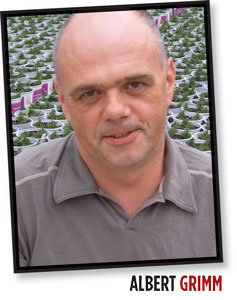5/27/2016
A Balancing Act
Albert Grimm

Nature is a wonderful concept. Just take a walk in your local forest or city park. The fresh air feels particularly nice when the weather turns sunny after a few days of rainfall. On such days, you can observe something very counterintuitive: the quality of the plants is simply amazing. Plants that were watered continuously for days show no sign of Pythium and there’s not a hint of Botrytis. The foliage stayed wet for days. Leaves were wet at nightfall and there was nobody who would have applied any protective fungicide. What would happen if we tried that in the greenhouse? All growers know that Botrytis is primarily caused by watering late in the day and root rot is caused by keeping soil continuously wet and not letting the roots dry completely between irrigations—is this not so?
When growers are stuck in the greenhouse for too long, we tend to develop a peculiar type of tunnel vision. The battle with the elements of plant production takes its toll. We feel engaged in some sort of trench warfare with a world that wants nothing but to destroy our crops, and the omnipresent spray-lance turns into an almost Quixotian symbol. We’re so focused on pests, diseases and nutrient deficiencies that we no longer see any nature in our crops. Nature is phenomenally successful, yet she doesn’t need to resort to industrial efficiencies, nor does she need to consult any recommendations for protective spray rotations. It might just save us time and grief if we better understand how plants survived for millions of years without our help.
From my perspective, the secret to nature’s success is balance. Plants evolved to compete in the environment they find in their natural habitat. Each species has developed methods to balance itself against competition from a multitude of challengers. The deeper we understand this, the better we can identify what’s out of balance when typical production problems cause trouble for our crops. Let me explain with the example of Botrytis:
Botrytis is a saprophyte. Typically, this fungus colonizes dead or dying plant tissue and feeds on the leftover nutrients. Without leaf debris as an initial substrate, the incidence of crop damage from Botrytis is so dramatically reduced that mechanical removal of dead tissue has been suggested as a more effective control than fungicide treatments.
Ultra-dense crop spacing in our production greenhouses results in an abundance of naturally senescing leaves. Bottom leaves that grow in very deep shade use more carbohydrates than they’re able to produce and our plants respond with leaf abscission just as they’ve learned in nature. The warmer we run our greenhouse temperatures, the faster these leaves run out of energy. Decaying leaves, along with the moist micro-climate inside a dense canopy, make an ideal substrate for Botrytis.
If we heat our crops to summer temperatures during dark, cloudy winter months, we further disturb the energy balance in the foliage, and we extend the problem to more and more leaves in densely spaced crops. If we want to control Botrytis, we should minimize leaf senescence and we can do this by simply balancing canopy size, available space, production temperature and available light. Did you notice that, so far, our irrigation practices had nothing to do with the initial incidence of Botrytis?
It’s rather futile to hope for Botrytis control from fungicides alone. Senescing leaves are well hidden from view, and therefore, hidden from our spray gun. They’re exceedingly difficult to coat with any contact fungicide, yet they would need the protection more than any other part of the plant if we aim to prevent Botrytis. The dense spacing simultaneously creates the dead tissue, which is necessary for Botrytis to develop, and it prevents the protective fungicide from reaching this dead tissue.
Systemic fungicides fare no better because they’re absorbed by the tissue and transported through the plant. However, the tissue needs to be alive for this transport to happen. Senescing leaves are no longer supplied by the plant and dead tissue no longer actively absorbs the protective chemicals.
When crop problems make you feel like Don Quixote fighting windmills, it might be time to take a long, contemplative walk in nature. At the very least it will be excellent for your nerves.
GT
Albert Grimm is head grower for Jeffery’s Greenhouses in St. Catharines, Ontario, Canada.